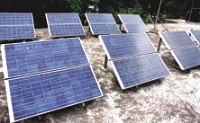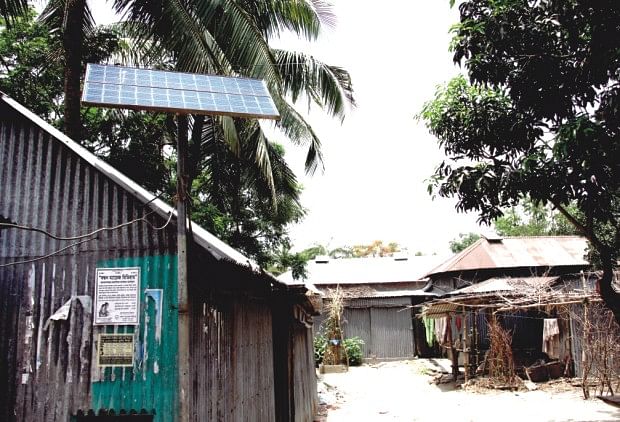| Home - Back Issues - The Team - Contact Us |
 |
| Volume 10 |Issue 20 | May 27, 2011 | |
|
|
Energy A Renewed Interest in the Electricity crisis Ahmed Abu Bakr
As you read this, more than 700,000 solar panels are busy within Bangladesh, generating clean energy for rural homes- and the number rises every day. People who were once deprived of access to electricity can now enjoy lighting, ceiling fans, mobile phones and even televisions. Everyone knows of Grameen Bank and how it has vaulted Bangladesh onto the international stage; sadly, few of us know that our nation is also recognised as the only one in the world which has been able to successfully adopt solar technology on such a large scale. We are at the head of the column when it comes to adoption of renewable energy technology; and yet, every year the citizens of Bangladesh are faced with the problem of power outages. It is a testament to human ingenuity that while all over the world, solar technology is deemed too expensive, solar technology has been made affordable for rural households in Bangladesh; financial innovation has allowed rural households to own such technology at the same rate as their monthly expenditure on kerosene. The man behind this revolution is Dipal C Barua. Starting in 1996 with Grameen Shakti, he devised an installment based payment structure and a supporting business model to market Solar technology to rural households that have no grid connectivity. Impressively, an entire RET (renewable energy technology) industry is now on the rise in Bangladesh. The cost of purchasing a solar home system, powerful enough to run 5 CFL lamps, 5 ceiling fans and a 21” colour television (400 W combined) for four hours, is a little less than BDT 200,000. Obviously, rural households consume much less energy and thus the SHS they own are much less powerful and in turn much less costly. It is difficult to assess the electricity consumption of urban households in Bangladesh. However, according to the world energy organisation, in 2005, the average energy consumption per capita in Bangladesh was 61 kWh. The initial cost of owning a solar system is undoubtedly quite high. It makes little sense at first to purchase a solar system when we get such cheap electricity off the grid. This is in fact one of the reasons for which we haven't heard much about solar technology within the cities and towns of Bangladesh. The thing about solar energy technology is that once the system has been purchased, energy consumption is costless. Yes, there are maintenance and battery replacement costs, but given that on average, an SHS lasts for 20 years after purchase, despite the high initial cost, it is actually a cheap alternative. What is even more important is that it gives us clean, renewable energy in a time when the world is faced with severe threats from global warming. It is also a currently available option unlike the power plants that our government is busy building. In addition, it has been made affordable because of innovative financial schemes that benefit both the purchaser and the seller. By spreading the cost of purchase over 24 monthly payments, the technology has been made affordable to millions. This in turn translates into tremendous economies of scale and cost savings. True, there is much room for improvement as far as energy output is concerned. But isn't it one of the prime challenges of our time to conserve energy? A constraint on the available amount of energy will automatically lead to a more prudential use of the energy resources we have. As citizens of Bangladesh, we are more than well-acquainted with the torment that we face every year due to our inadequate supply of electricity. In 2007, the electricity demand-supply gap was about 2000MW (Ministry of Power, Energy and Mineral Resources). The authorities are busy with the traditional supplies of energy- coal and oil power plants. These will lead to an increase in the supply of energy, but are disastrous for the environment. In addition, the domestic supply of coal and oil resources will eventually run out; as the world supplies also draw to an end, the prices will rise to prohibitive levels. Therefore, such investments are not worthwhile, because sooner rather than later they will become obsolete. The questions that inevitably come to mind are: Renewable energy technologies ARE the future. Why then is the Government not pushing for solar technology rather than fossil fuel based energy? When so many laws are passed every day, why hasn't the use of solar technology been made mandatory for households that can afford them? Dhaka city has a population of about 8.5 million. Assuming only one-third of the population is capable of purchasing a solar system, and 5 individuals per household, 225 MW of extra power could be generated. This may seem very inconsequential compared to the 2000MW gap, but we must keep in mind that the 2000MW gap is for the whole of Bangladesh and includes the industrial sector. Plus, if we consider that lower income households can also install solar home systems (of lesser capacity and cost), the extra power generated will probably reach 300-350 MW. If we look closer however, the 225 MW generated increases the overall electricity supply, but reduces the load on the grid, in effect working to reduce the demand-supply gap by 450 MW. Along with improving the energy situation in our country (in an environmentally responsible manner), this will also give rise to an industrial sector in Bangladesh. Why then are we not capitalising on this opportunity? When such a lucrative investment opportunity has presented itself, why are Bangladeshi entrepreneurs not delving into it? It has the capacity to give birth to both, manufacturing (solar panels and accessories like CFL lamps and other energy efficient appliances) and services industries (installation, repair, maintenance, research), creating millions of jobs. In addition, such an industry can take advantages of the Clean Development Mechanism (CDM), established in the Kyoto Protocol. One of the major issues in the energy industry is that of investment, and we already have a system in place to answer that issue. If we start early and capitalise on this, the country might also be able to specialise in this technology and broaden the base of the export sector. We must also take into account the rising costs of energy in foreign markets, and how the Bangladeshi model can be used to penetrate those markets. In fact, the business model that has allowed such wide dissemination of the solar technology is already being exported. The model has already created an accessible market at home and has the potential to create huge markets abroad. Why then are we not focusing on the manufacturing and services sectors that this industry has to offer? We hold the first mover advantage in this scenario- are we just going to let it be taken up by others while we do nothing? The writer is a Fellow of Jagoree - a non-partisan youth platform, and a student of NSU
Copyright
(R) thedailystar.net 2011 |

